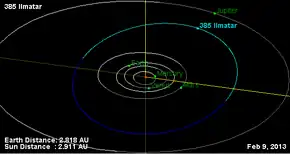 Orbital diagram | |
| Discovery | |
|---|---|
| Discovered by | Max Wolf |
| Discovery date | 1 March 1894 |
| Designations | |
| (385) Ilmatar | |
Named after | Ilmatar |
| 1894 AX | |
| Main belt | |
| Orbital characteristics[1] | |
| Epoch 31 July 2016 (JD 2457600.5) | |
| Uncertainty parameter 0 | |
| Observation arc | 122.12 yr (44604 d) |
| Aphelion | 3.19998 AU (478.710 Gm) |
| Perihelion | 2.50226 AU (374.333 Gm) |
| 2.85112 AU (426.521 Gm) | |
| Eccentricity | 0.12236 |
| 4.81 yr (1758.4 d) | |
| 166.647° | |
| 0° 12m 17.024s / day | |
| Inclination | 13.5514° |
| 345.021° | |
| 187.911° | |
| Physical characteristics | |
| Dimensions | 91.53±1.6 km |
| 62.35 h (2.598 d) | |
| 0.2129±0.008 | |
| S | |
| 7.49 | |
Ilmatar (minor planet designation: 385 Ilmatar) is a large Main Belt asteroid.
It was discovered by Max Wolf on March 1, 1894, in Heidelberg.[2] It was named after Ilmatar, virgin spirit of the air from the Finnish epic Kalevala. Its mass is unknown. Its rotation is 62.35 hr.
References
- ↑ "385 Ilmatar (1894 AX)". JPL Small-Body Database. NASA/Jet Propulsion Laboratory. Retrieved 10 May 2016.
- ↑ "Physics and Astronomy > Dictionary of Minor Planet Names > (385) Ilmatar". Springer Reference. Retrieved 20 October 2014.
External links
- 385 Ilmatar at AstDyS-2, Asteroids—Dynamic Site
- 385 Ilmatar at the JPL Small-Body Database
This article is issued from Wikipedia. The text is licensed under Creative Commons - Attribution - Sharealike. Additional terms may apply for the media files.